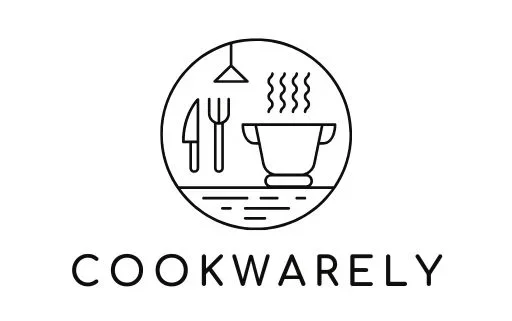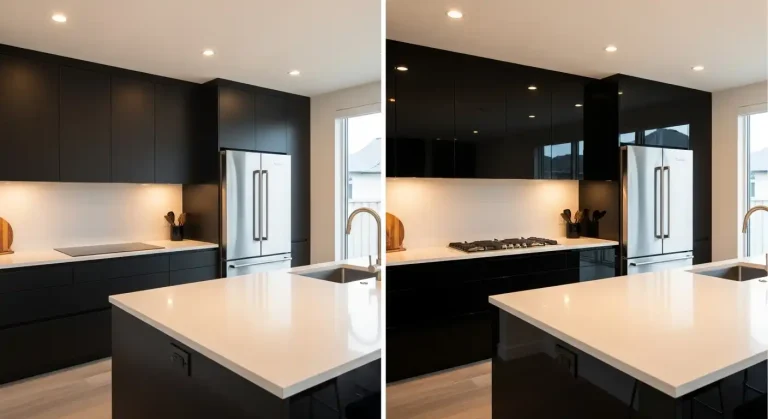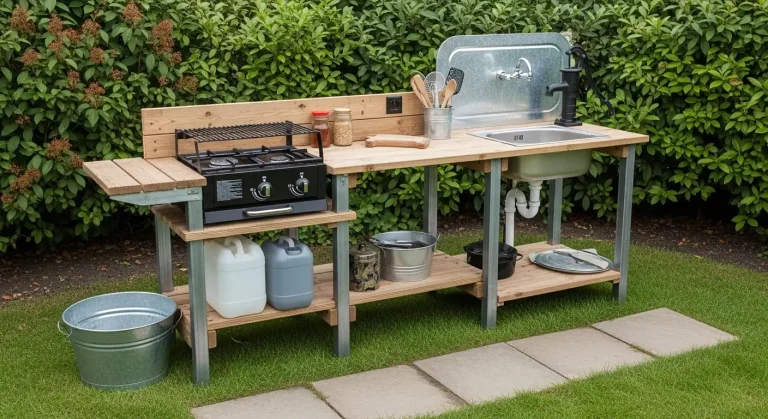How to Mix Textures for a Designer Kitchen Look
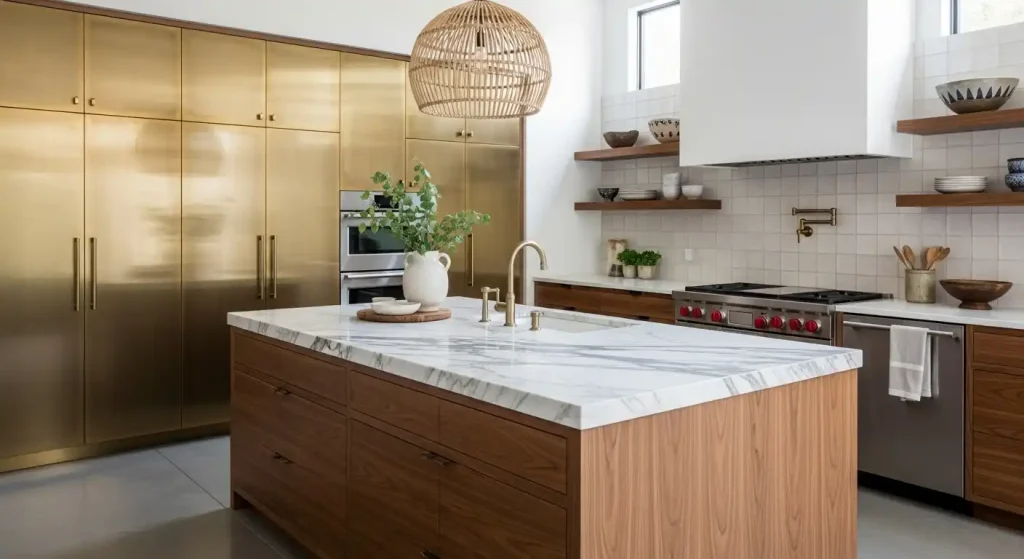
The secret to a kitchen that looks expensive isn’t your budget. It’s how you mix what you have.
Does your kitchen feel a little flat or boring? You are not alone. This happens when a room uses only one or two feelings. Think of all smooth cabinets and countertops. It has no life.
This guide will fix that. We will teach you seven simple rules used by designers. You will learn to confidently mix textures kitchen styles.
We will show you how to pair rough with smooth and matte with glossy. These tricks build depth and visual interest.
By the end, you will know how to create a true designer kitchen look. Let’s begin.
The Golden Rule: Balance is Everything
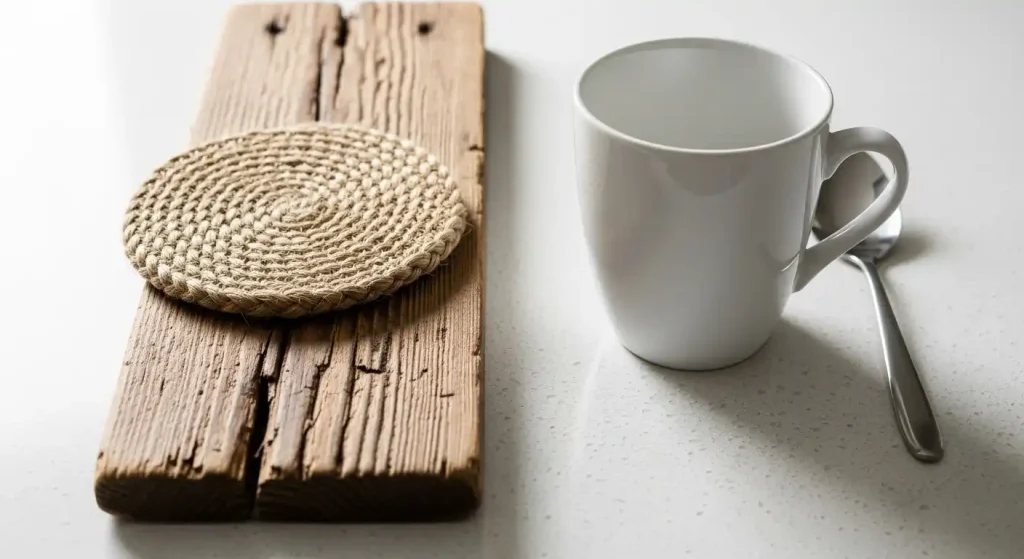
Think of your kitchen like a good meal. You wouldn’t want every bite to be only salty or only sweet.
You need a mix of flavors. It is the same with textures. The goal is to create a room that feels good, not messy or boring.
The biggest mistake is using only one type of texture. A kitchen with all glossy cabinets and shiny counters feels cold.
A room with only rough wood and brick can feel like a cabin. Your job is to find a middle ground.
Here is the simple rule to remember: balance textures. For every rough thing, add something smooth. For every matte finish, add a little bit of shine.
Look at this example. A kitchen has rough wood beams on the ceiling and a bumpy jute rug on the floor. It also has woven baskets for storage.
This is a lot of rough texture. To fix it, you add sleek white cabinets and a polished stone countertop.
The smooth surfaces balance the rough ones. Now the room feels designed, not just decorated.
This balance makes a room interesting. Your eye moves around to see everything. It feels complete.
Start by looking at your kitchen. Is it all one note? Find one thing to add that feels the opposite.
Start With Your Big Three: Cabinets, Counters, & Flooring
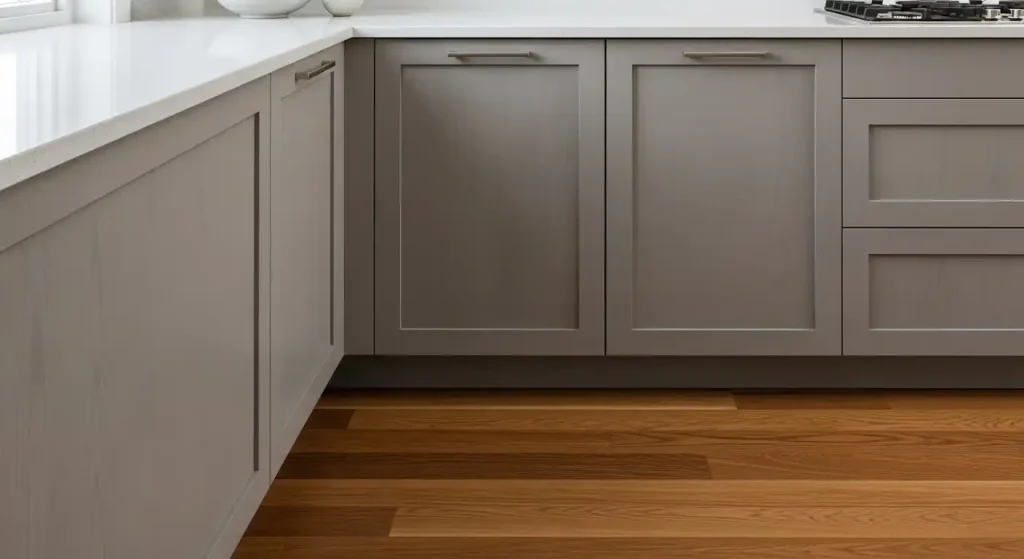
You don’t need to start from scratch. Look at the three biggest things in your kitchen first. These are your cabinets, your countertops, and your floor.
They set the stage for everything else. Think of them as your foundation.
Your job is to figure out what these big surfaces feel like. Are they mostly smooth, natural, or rough?
Shiny laminate cabinets are smooth. A granite countertop with specks is natural. A tile floor with a bumpy surface is rough.
This step is important because these big materials cost the most money.
In fact, cabinets and countertops alone can eat up over half of a remodel’s budget. You want to get their texture right from the start.
Once you know your foundation, your task gets easier. You simply add contrast.
If your cabinets and counters are smooth and shiny, you need to add some rough or matte kitchen texture ideas.
Try a woven basket or a wood cutting board.
If your floor is rough tile, balance it with a sleek cabinet. Your big three give you the clues. They tell you exactly what is missing.
7 Textures to Layer for a Designer Kitchen Look
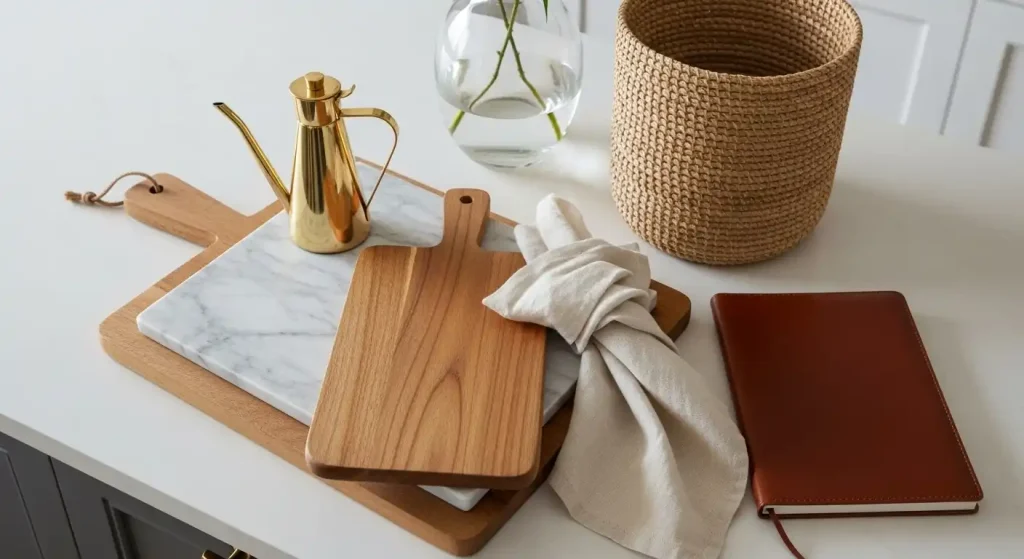
Your big three set the stage. Now it’s time to add the layers that make a kitchen special.
These textures are your tools. Mix and match them to create a room that feels collected and personal.
Here are the seven best textures to use.
1. The Strength of Stone & Engineered Quartz
Stone is a powerhouse of texture. But it’s not all the same. Each type gives a different feeling. Veiny marble has a busy, visual pattern you can see.
Honed granite has a soft, matte feel you can touch. Polished quartz is completely smooth and shiny.
You can use stone in more than just countertops. Think about a stone sink or a marble shelf. It adds a touch of luxury that is hard to match.
2. The Warmth of Wood
Wood is the easiest way to make a kitchen feel warm and lived-in.
It is the opposite of cold, sterile surfaces. You probably already have some wood. Look at your floors or cabinets.
You can add more wood in simple ways. Try open wood shelves instead of upper cabinets. Use a butcher block on top of your island.
Even a wood bowl on the counter helps. For a great contrast, put matte wood shelves next to glossy white cabinets.
3. The Industrial Edge of Metal
Metal does more than just hold your cabinets shut. It adds a cool, industrial feeling.
Most kitchens already have some metal in the faucet and appliances.
You can get creative with it. Try a zinc countertop for a unique look. Choose a statement light fixture made of iron or brass.
A simple tip: you can mix metal colors like brass and chrome. Just try to keep the finish the same.
Use all brushed metals or all polished ones. This keeps it from looking messy.
4. The Tactile Touch of Textiles
This is the most forgotten texture. Fabric makes a room feel soft and cozy. A kitchen without any fabric can feel a bit like a laboratory.
Adding textiles is an easy fix. Start with a rug in front of the sink. It saves your feet and adds color. Then, look at your windows.
Roman shades made from fabric add softness. You can even upholster your barstool seats with a fun pattern.
5. The Artisanal Quality of Glass & Tile
Glass and tile are perfect for adding pattern. A glossy subway tile is a classic for a reason.
Its smooth surface reflects light and makes the room brighter.
For more character, try handmade tiles. Zellige tiles are slightly uneven. This gives your backsplash a custom, artisanal look.
For your cabinets, consider doors with ribbed glass. They let you hide clutter while adding a nice linear texture.
6. The Organic Feel of Woven Materials
Woven textures are like wood’s best friend. They also add warmth, but in a lighter, more organic way. They make a kitchen feel casual and welcoming.
This is one of the easiest textures to add. Place a few seagrass baskets on open shelves to hold potatoes or towels.
Swap out your counter stools for ones with rattan seats. For a bigger change, look for cabinet doors with cane weaves.
7. The Modern Punch of Concrete & Leather
For a sleek and modern look, try concrete and leather. Concrete has a cool, matte feeling.
It is perfect for countertops or small shelves. It pairs well with warmer woods.
Leather is a surprise hit in kitchens. It feels warm and soft in your hand.
The easiest way to use it is with cabinet pulls. Replace your metal knobs with leather straps. It adds a unique touch no one will expect.
How to Combine Textures: A Practical Formula
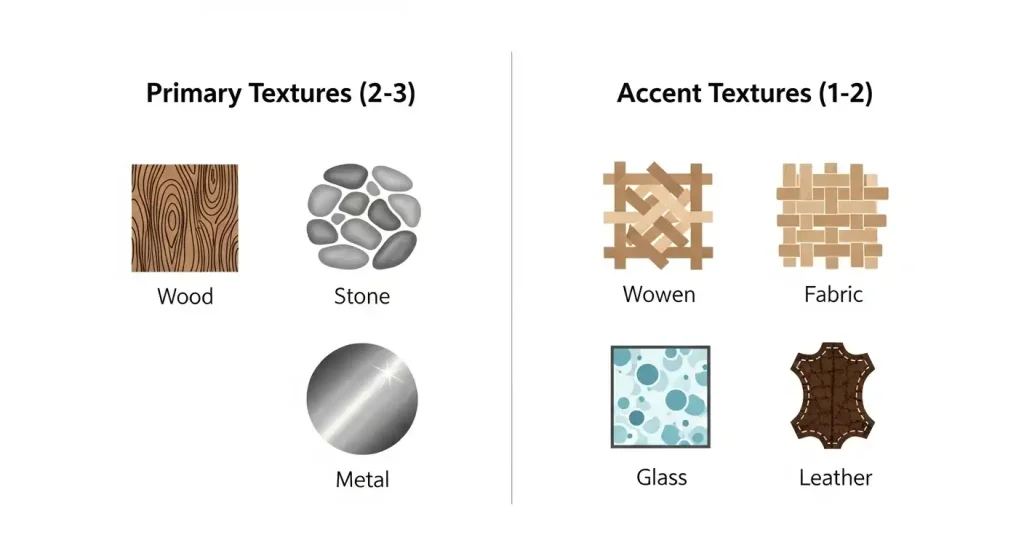
You have your list of textures. Now, how do you put them together without making a mess?
Use this simple formula. It makes how to add texture easy and stops you from going overboard.
First, pick two or three main textures. These are your big players. They usually come from your largest items.
Think of materials like wood for your floor, stone for your counter, or metal for your appliances.
Next, choose one or two accent textures. These are your smaller details.
They come from your decorations and accessories. Good choices are woven baskets, a glass lamp, or leather pulls.
Do not use every texture on the list in one room. That creates chaos, not style. Designer Kelly Wearstler is a master of this balance.
She often pairs huge, rough stone walls with soft, sleek velvet furniture. She uses a few strong textures instead of many weak ones.
Stick to your formula. Two or three big textures. One or two small ones. That’s all you need to create a layered, interesting look.
Common Mistakes to Avoid When Mixing Textures
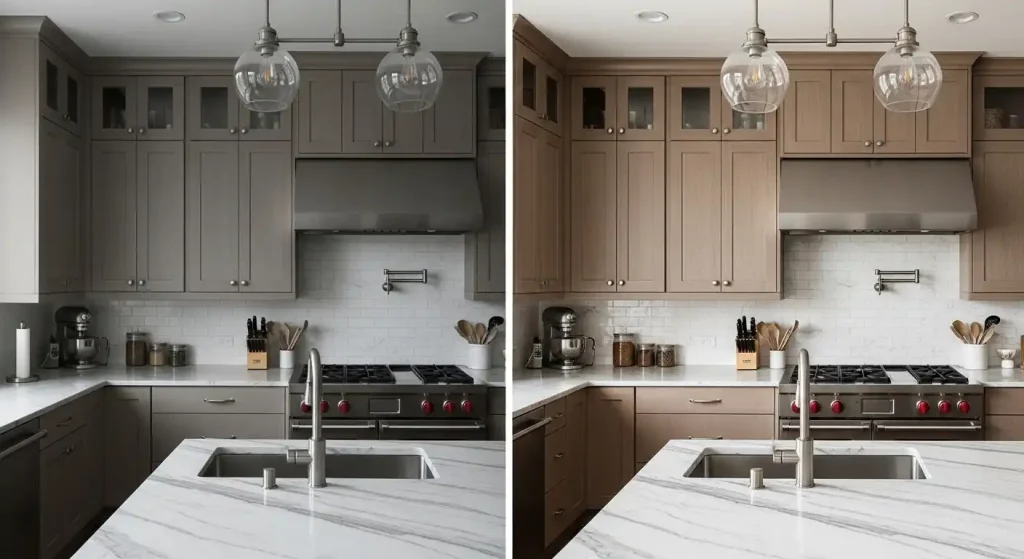
Even with a good plan, you can make mistakes. Here are three big ones to watch for.
First, ignoring your light. Textures need light to be seen. A matte surface in a dark corner will just look flat.
Make sure you have good overhead and counter lighting. This makes all your textures pop.
Second, forgetting about size. A very large, rough texture can take over the whole room. A huge brick wall might be too much.
A smaller brick backsplash could be just right. Always think about the scale of your texture compared to your space.
Third, matching everything perfectly. Your goal is a collected look, not a showroom. It’s okay if your wood tones are slightly different.
Your metals do not need to be identical. A little variation makes the room feel lived-in and personal. Too much matching feels stiff and unnatural.
Conclusion
Creating a kitchen you love is about smart contrast. It is not about buying the most expensive things. It is about pairing what you have in new ways.
Start with your big surfaces. Then, add layers that feel different. Smooth next to rough. Matte next to glossy.
You do not need to do everything at once. Start small. Grab a woven basket for your fruit. Swap out your cabinet hardware for something new.
Add a runner with a nice texture. Hold your material samples together under your kitchen light. See what feels right.
This is how you learn to mix textures kitchen styles with confidence. Your dream kitchen is not in a magazine. It is right in front of you, waiting to be built.
